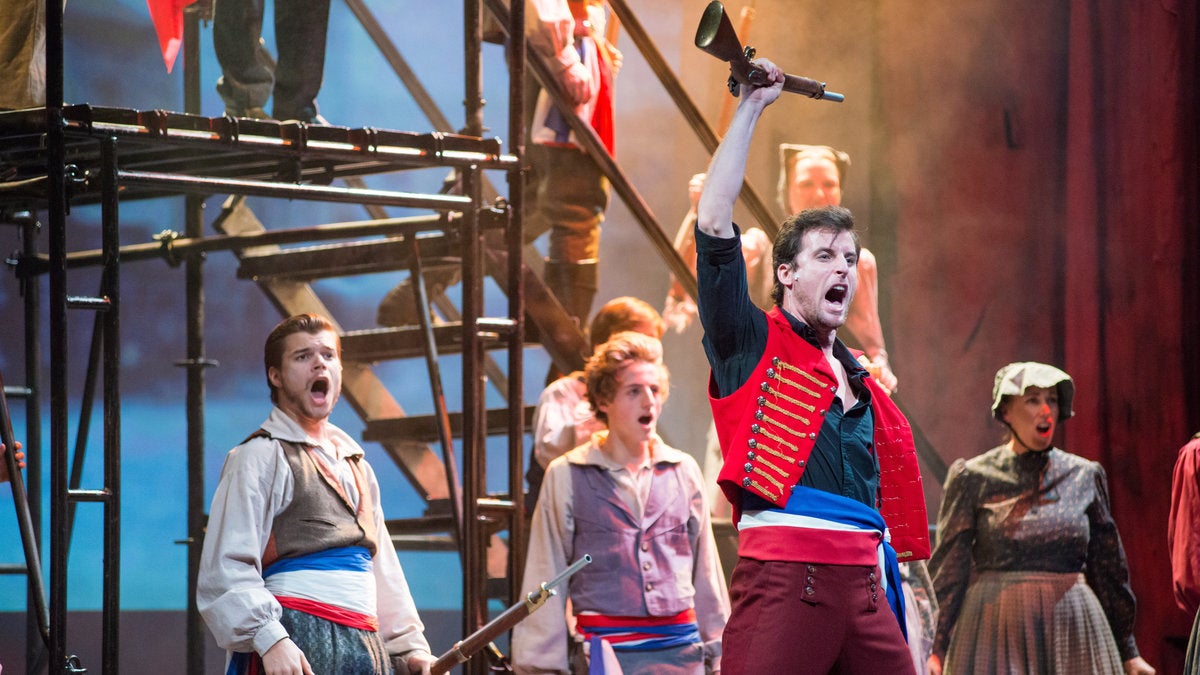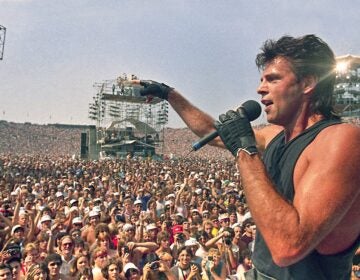Review: ‘Les Misérables’ with imagery

Sean Thompson (in front), leads the student rebels in Media Theatre's production of 'Les Misérables.' (Photo courtesy of Maura McConnell)
Once upon a time anyone who wanted to professionally produce “Les Misérables” had to obey strict mandates that included using a stage on a huge turntable, an expensive proposition. But in 2006 — 21 years after the show debuted — producer Cameron Mackintosh invited the Walnut Street Theatre and a handful of others to completely restage the musical. Out went the turntable and other conceits. In came new ideas.
The Media Theatre’s idea, much like the current revival of “Les Miz” on Broadway, employs multi-media – images that fill the entire back wall of the stage. In Media’s current production of “Les Miz,” as everyone calls the musical taken from Victor Hugo’s sprawling 1862 novel, the images serve to define the moment. Even though the show’s playbill oddly fails to mention any multi-media designer, the images are the show’s indelible aspect.
Fire rages as French prisoners do hard labor, and pictures of the insides of places give a scene depth. Paris streets appear as the student revolutionaries on stage fight the elite. Less successfully, completely out-of-place tanks appear in the 1800s and the antagonist Javert takes an apparent dip in the apparent Seine. (Until then, there’s been no sign of a river on the rear-stage wall image or in the scene.)
No doubt, artistic director Jesse Cline’s “Les Miz” is a major undertaking – with its demanding sung-through music (Alain Boublil, Claude-Michel Schonberg and Herbert Kretzmer) that moves through the life of Jean Valjean, the released prisoner who becomes an all-around mensch. “Les Miz” is set after the French Revolution, long before we all loved Paris every season of the year, and when the ideals of liberty, fraternity and equality were fine if you were rich.
The show itself has a contagious passion. When students mount the barricades against the aristocratic establishment, we’re with them bullet for bullet. (The battle is well-done at Media, in Troy Martin O’Shia’s gunfire-light and Carl Park’s bullet-sounds.) And how can we turn away from little Cosette – the indentured waif whose caricature is Les Miz’s well-known poster child – when she sings of far-away castles where no child is allowed to cry? How can we not side with Jean Valjean when in quiet musical desperation, he begs God to send his daughter’s lover safely home from battle?
Media’s production mines all of this, and by the end is solidly affecting. Still, it has to overcome a major misfire: the general quality of the sound. The cast is heavily amplified, apparently to compete with the excellent musicians who, under Christopher Ertelt’s direction, are simply too loud. I felt at many points as though the cast was accompanying the orchestra, not the other way around. This is exacerbated by the theater’s auditorium – toward the rear of the house, the sound begins to blend into a din. So if you’re planning to see this “Les Miz,” see it toward the front.
That’s what I did in the second half, moving up from a seat in the rear, and the sound quality was somewhat improved. The pity here is that all the plot’s revealed in song, and so many words are lost that unless you know the story you’ll have some trouble figuring it out.
Cline’s production calls for a built-out stage, which encompasses the musicians in the pit and allows some of the characters to come forward and declaim in song. But the jut-out doesn’t completely shield the orchestra – particularly trombonist Anthony Triplett who, with his lighted music stand, becomes the most constantly visible figure in the show.
None of this is a deal-killer for audiences whose desire to see “Les Miz” at the Media, a theater devoted solely to musicals, has spurred the stage company to extend the show a week, through Jan. 18. What Les Miz’s fans get is a fine-looking production with a cast that hits all the major moments. John D. Smitherman is a forceful Jean Valjean; he has a striking tenor voice that in the highest range is drowned by the orchestra. He appeared to have a mild cold the night I went, but his interpretation was straight-on.
James Zannelli is an ever-threatening Javert. Elisa Matthews’ version of “I Dreamed a Dream,” sung by her character Fantine, is a highlight, and Sarah Moya’s rendition of “On My Own,” as Eponine, is a house-stopper. Lauren Cupples is a lovely Cosette, Zach Monroe is her Marius, and the strong-voiced Sean Thompson is the leader of the band of students who revolt. Kelly Briggs and Susan Wefel are the scroungy husband and wife who will do anything to cheat you out of a franc – a more nasty comic relief than in other productions. The night I saw the show, three performing children did a very good job.
My favorite part of “Les Miz” is a throwaway song – “Drink with Me to Days Gone By,” a piece sung by the ensemble just before the student revolt begins. It’s a sentimental little thing, but lovely music, and nicely done here.
“Les Misérables” runs through Jan. 18 at Media Theatre, 104 E. State St., Media. 610-891-0100 or www.mediatheatre.org.
WHYY is your source for fact-based, in-depth journalism and information. As a nonprofit organization, we rely on financial support from readers like you. Please give today.




